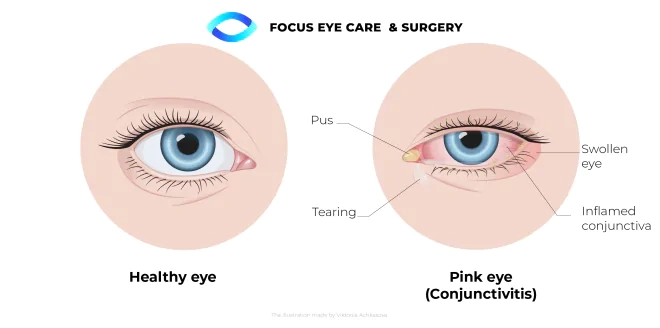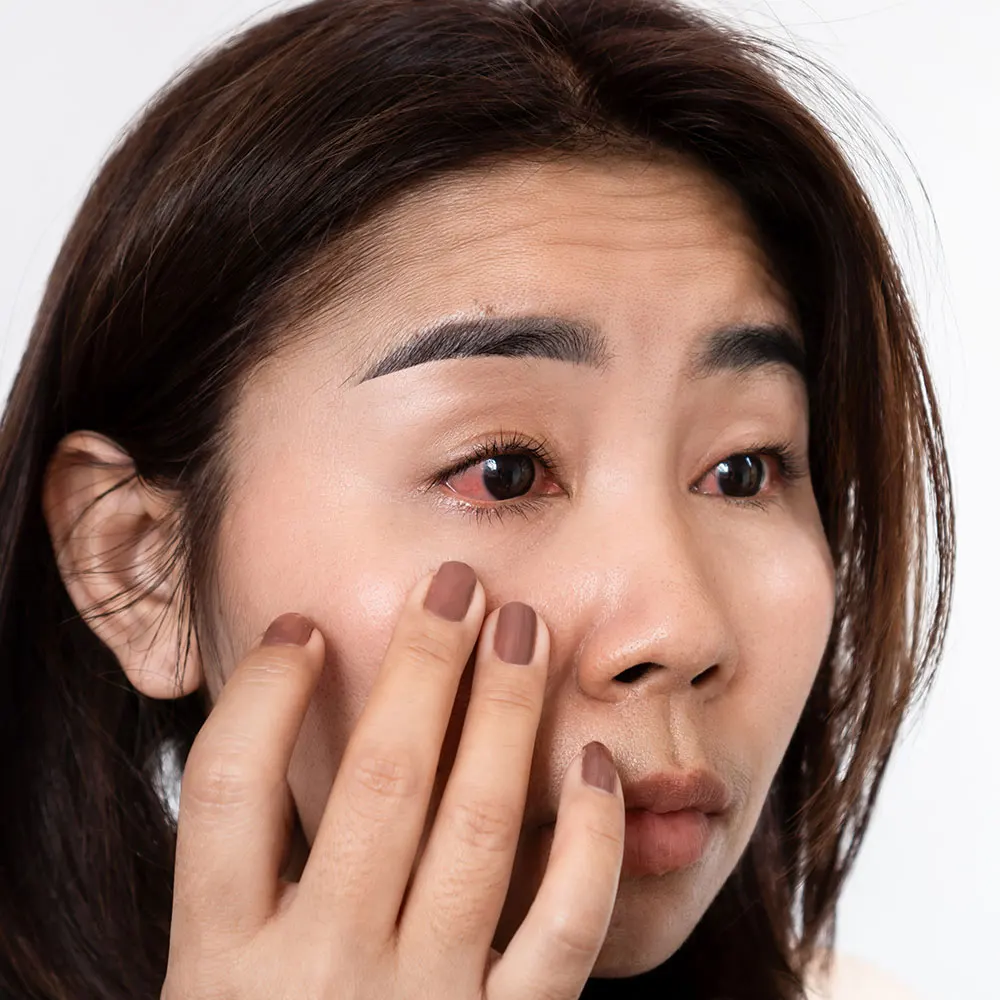
Pink Eye (Conjunctivitis)
Pink Eye (Conjunctivitis)
Are your eyes red, itchy, and watery? Does it feel like there’s something in your eyes you can’t blink away? Or do your eyes have discharge that makes your vision blurred or hazy?
Schedule a consultation with us today to get your eyes checked by an eye doctor in New York. Dr. Ghaznawi provides a thorough checkup so you get the kind of care and treatment best suited to your individual needs.

What Is Pink Eye?
The tissue that covers the white part of the eyeball is called the conjunctiva. Pink eye happens when the conjunctiva appears reddish due to blood vessels becoming inflamed; hence the medical name conjunctivitis. While the white part of the eye is often the most affected, the inside of the eyelid, which is covered by the same tissue, may also be inflamed. The infection starts from one eye and may spread to the other so that both eyes become affected.


Virus, bacteria, or allergies may cause pink eye. Viral and bacterial conjunctivitis easily spread from person to person while allergic conjunctivitis does not.
Viral conjunctivitis
Viral conjunctivitis occurs when pink eye is caused by adenovirus, the same virus causing common cold. Not surprisingly, some people who have pink eye also have runny nose and sore throat. Burning sensation of the eyes with watery discharge are the most common symptoms. Like any virus-borne diseases, infections are likely to occur in crowded places. The infected person is most contagious when their eyes are red and teary. Similar to stopping the spread of common cold, washing hands, not sharing personal items, and not touching the eyes are just some of the practices that help minimize infecting another person.
Bacterial conjunctivitis
When sticky pus comes out of the infected eye that is sore and red and feels gritty, that pink eye may be caused by bacteria. Discharge often forms into a crust on eyelashes during the night, sealing the eyes shut. Some of the most common bacteria causing this type of conjunctivitis come from the same family of bacteria causing strep throat.
Allergic conjunctivitis
When pink eye is the result of the conjunctiva reacting to irritants, allergic conjunctivitis occurs. Irritants may range from cigarette smoke or car fumes to pollen or pet dander. In allergic conjunctivitis, eyes are not only red and intensely itchy but also highly sensitive to light. Some people also experience symptoms of nasal allergies such as itchy nose and sneezing.
What Are the Symptoms of Pink Eye?
Pink eye may present as a combination of any of the following symptoms:
- red or burning eyes
- itchy eyes (intense itching in the case of allergic conjunctivitis)
- a gritty sensation in the eyes
- swollen eyelids, often in the case of allergic conjunctivitis
- sensitivity to light
- hazy vision
- pain in the eyes, as with bacterial conjunctivitis
- watery or fluid discharge from the eyes that glues eyelashes together

Pink Eye FAQs
Generally, pink eye is not a cause for concern as it either resolves on its own or is easily treated by antibacterial or anti-allergy medications.
But in the wake of the COVID-19 pandemic, individuals who suspect they may have the disease should keep a close eye on conjunctivitis.
This is because in rare cases, pink eye emerges as a new symptom of COVID-19. According to the American Academy of Ophthalmology, only 1 to 3 percent of those with COVID-19 develop pink eye.
Pink eye on its own is highly unlikely a symptom of COVID-19, and should therefore be treated like any other type of conjunctivitis. But if it’s coupled with fever, cough, or shortness of breath, the presence of pink eye may indicate that it is yet another symptom of the rapidly evolving disease.
Pink eye or Conjunctivitis may be transmitted either by:
– hand to eye contact with an infected person’s pink eye discharge
– bacterial spread from the infected person’s nose and sinuses
– poorly cleaned contact lenses
– poorly fitted contact lenses
– use of decorative contact lenses
Viral conjunctivitis is the most common type of pink eye. This type of conjunctivitis, together with the bacterial variety, is the most contagious form of the disease.
While pink eye may affect any age group, children appear to be the most vulnerable because of their close contact with many other children who may lack proper hygiene.
Conjunctivitis treatments depend on the type of pink eye a person is infected with. Medication for one type will not work for another. Schedule a visit with our New York eye doctor to get the correct diagnosis and treatment.
Viral conjunctivitis
No specific treatment applies to viral conjunctivitis, which often clears on its own in two weeks. As in other diseases caused by viruses, the goal of treatment is to ease symptoms. One of the easiest to do at home is applying cool, wet compresses to the affected area as well as application of artificial tears for lubrication.Symptoms that don’t get better after two to three weeks, or symptoms that become severe, require a visit to an eye doctor.
Viral conjunctivitis will not get better from medication meant for other types of pink eye. If your pink eye symptoms still bother you after two weeks, you may need to see an eye specialist to keep your vision clear.
Bacterial conjunctivitis
Like viral pink eye, mild bacterial conjunctivitis may also clear on its own without treatment and without further complications. Wait up to a week for this type of pink eye to improve, and as long as two weeks for it to clear altogether.
In cases where certain bacteria are suspected, or if pus is present, medication may be required. A person whose immune system is weak and suffers from pink eye may also need antibacterial treatment. The treatment helps prevent the spread of bacteria, reduces the length of infection, and minimizes the risk of complications.
Allergic conjunctivitis
Anti-allergy medication (eye drops or oral) is the first line of treatment for pink eye caused by allergens and irritants.
Relief of symptoms may also be achieved by applying artificial tears and cold compress. Prevention measures such as avoiding triggers, washing of face or showering before bedtime after exposure to allergens, and frequent washing of clothes may help keep allergies at bay. For those experiencing year-round allergies, allergy immunotherapy may be an option.
Because pink eye itself is just a symptom of an underlying disease, in this case the novel coronavirus, your pink eye will start to clear once the cause is treated.
If you have accompanying fever as well as respiratory symptoms such as coughing or shortness of breath, call a doctor right away to be referred to the right medical center for proper evaluation and treatment.


Are You a Candidate for
Vision Correction?
Whether you just need a general eye exam, or if you are interested in reducing or eliminating your need for glasses or contacts, our team is here to help! Contact us to book an appointment today!
The doctors at Focus Eye Care & Surgery have reviewed and approved this content.
Page Updated:


